Zonda Provides New Home Market Update Sept 2025
Originally Published by: Zonda — September 22, 2025
SBCA appreciates your input; please email us if you have any comments or corrections to this article.
In August, the new home market saw a modest 2.1% month-over-month increase in total transactions. This growth was supported by a 10.8% rise in new home inventory and coincided with many builders launching sales campaigns. In addition, sales continued to be supported by the widespread use of incentives and price cuts.

While this report focuses on August, the more significant story has unfolded in September. The recent decline in mortgage rates—staying below 6.5% for most of the month—represents a meaningful shift for the housing market. Although this may not feel like a major drop for those accustomed to 2% or 3% rates, even small reductions can have a major impact on affordability.
“Moving from 7% to 6.5% mortgage rates puts 2.1 million more households in a position to buy. If rates were to fall to 6%, that number more than doubles, pricing in another 4.2 million households,” said Ali Wolf, Chief Economist for Zonda and NewHomeSource. “While we don’t expect consumers to rush back to the market overnight due to lingering economic uncertainty, this is a clear step in the right direction.”
New home sales ticked up in August
Zonda’s new home sales metric counts the number of new home contract sales each month and accounts for both cancellations and seasonality. This metric shows there were 703,003 new homes sold in August on a seasonally adjusted annualized rate. This was a gain of 2.1% from last month and a drop of 1.2% from a year ago. On a non-seasonally adjusted basis, 59,104 homes were sold, 0.4% lower than last year and 8.8% above the same month in 2019.
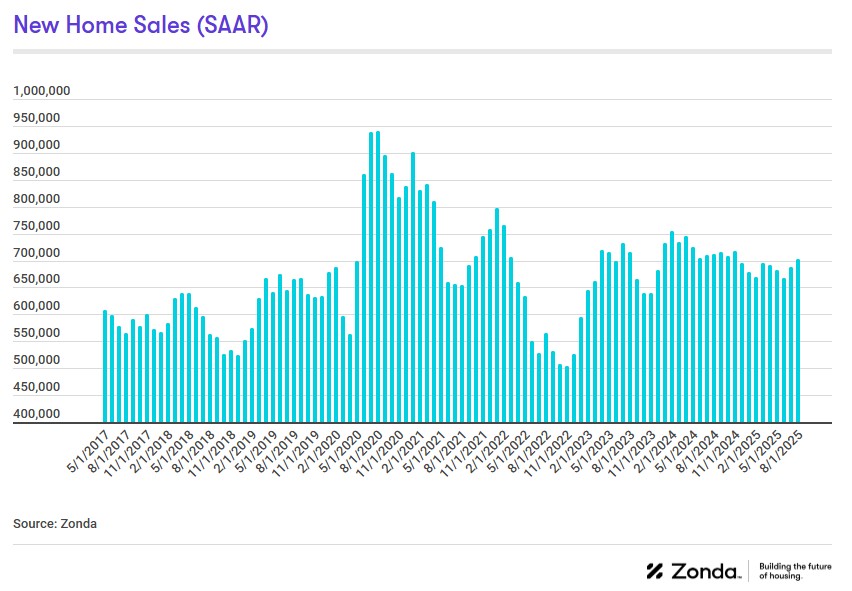
PSI: Up MOM, down YOY
Zonda’s New Home Pending Sales Index (PSI) was created to help account for fluctuations in supply by combining both total sales volume with the average sales rate per month per community. The August PSI came in at 137.1, representing a 3.8% decline from the same month last year. The index is currently 21.3% below cycle highs. On a month-over-month basis, seasonally adjusted new home sales increased 5.1%.
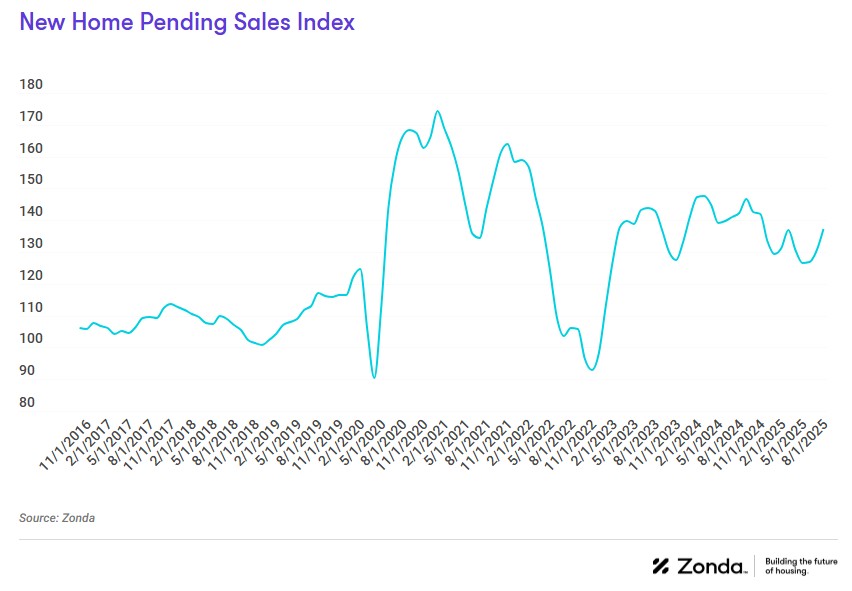
- The markets that posted the best numbers relative to last year were Salt Lake City (+14.4%), Jacksonville (+5.8%), and Raleigh (+3.7%). Salt Lake City was up compared to the last year and grew 21.3% month-over-month.
- Inversely, the metros that performed the worst year-over-year were Sacramento (-19.1%), Charlotte (-17.6%), and Tampa (-16.7%).
- On a monthly basis, Salt Lake City, Austin, and San Francisco were the best performing markets.
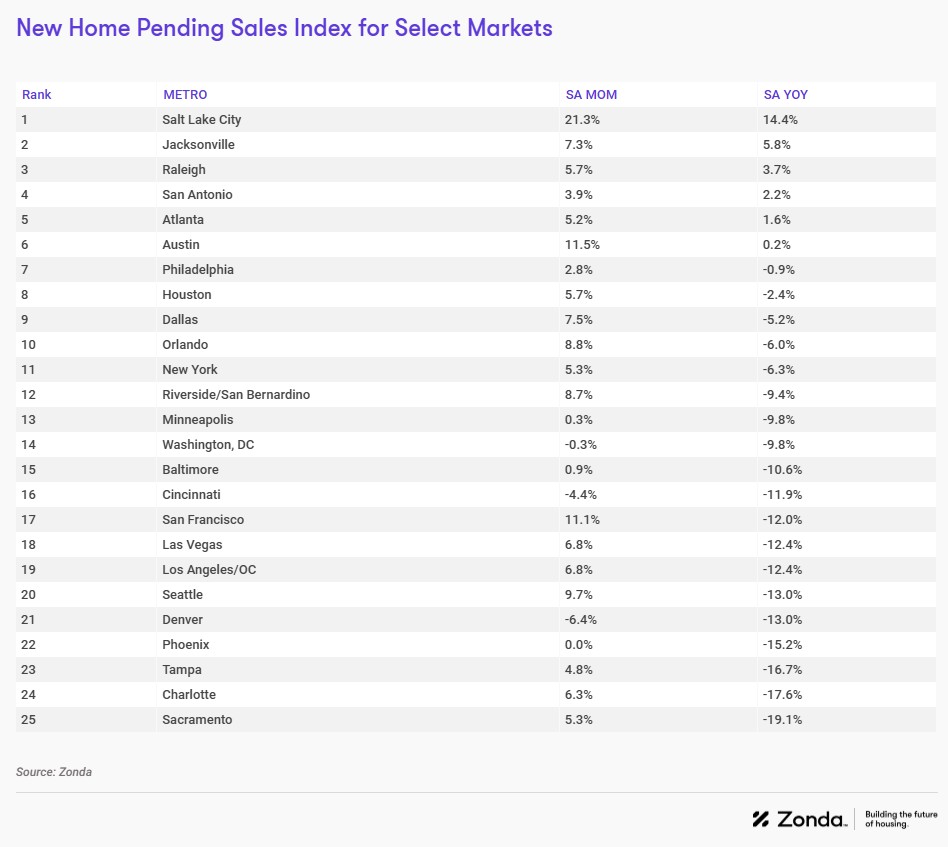
Market conditions remained average for yet another month
In order to add further context to sales, Zonda created the Zonda Market Ranking (ZMR). The ZMR accounts for both sales pace and volume, is seasonally adjusted, and is taken as a percentage relative to a baseline market average. Based on the percentage above or below baseline, markets are bucketed into performance groups ranging from significantly underperforming to significantly overperforming relative to historical activity.
The map below shows a snapshot of top production markets by region. Zonda also offers the ZMR for entry-level, move-up/move-down, and high-end markets. Subscribers of the National Outlook report can access all top markets and the tiered breakdown in Zonda’s portal. Non-subscribers can access the tiered maps for the select 10 markets by clicking below.
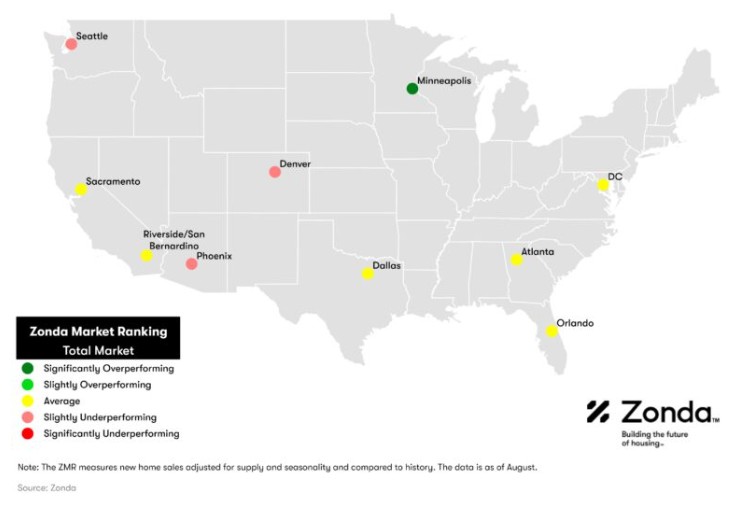
- The National ZMR index came in at 108.9 in August, which was flat month-over-month and continues to indicate an average market. The National ZMR has been average throughout 2025 so far after being rated slightly overperforming for all of 2024.
- Zonda’s snapshot markets were split between 10% overperforming, 60% average, and 30% underperforming, largely consistent with last month’s numbers. Among Zonda’s top 50 major markets, 32% were overperforming, 42% were average, and 26% were underperforming.
- Importantly, the ZMR does not account for what it takes to sell a home. For example, securing a sale might still feel difficult in a significantly overperforming market, but if the incentives offered result in a sale, we count the sale.
Pricing was mixed this month
Prices fell 1.1% for entry-level to $324,813 but rose 0.6% for move-up to $517,561 and 1.9% for high-end homes to $923,420. While the price increases seem counterintuitive to reality, the rise could be a result of new communities opening at higher prices given land and construction costs.
Supplementing our data with a survey Zonda conducts monthly, 42% of builders lowered prices in August, 55% held prices flat, and only 3% raised prices. In July, for comparison, 33% of builders lowered prices MOM, 61% held prices flat, and 6% increased prices.
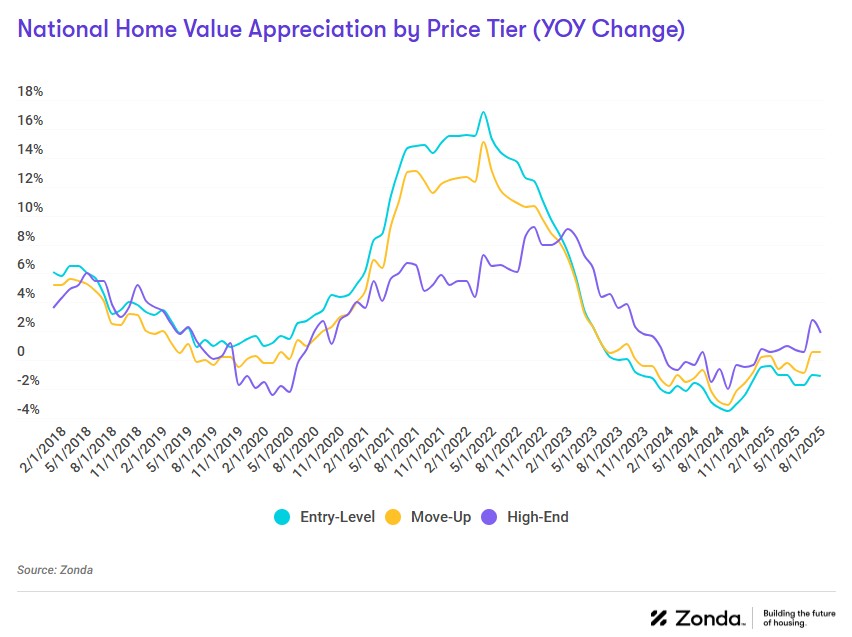
Incentives are still common in today’s housing market to help address the affordability constraints for buyers. In August, 59% of new home communities offered incentives on to-be-built homes and 78% on quick move-in supply. Note, these are only publicly advertised incentives so will underrepresent overall usage.
Community counts are slowly returning to ‘normal’
There are currently 16,776 actively selling communities tracked by Zonda, up 10.8% from last year. On a month-over-month basis, the national figure grew 0.7%. The national community count is up for the 9th consecutive month but remains 12.6% below the same month in 2019.
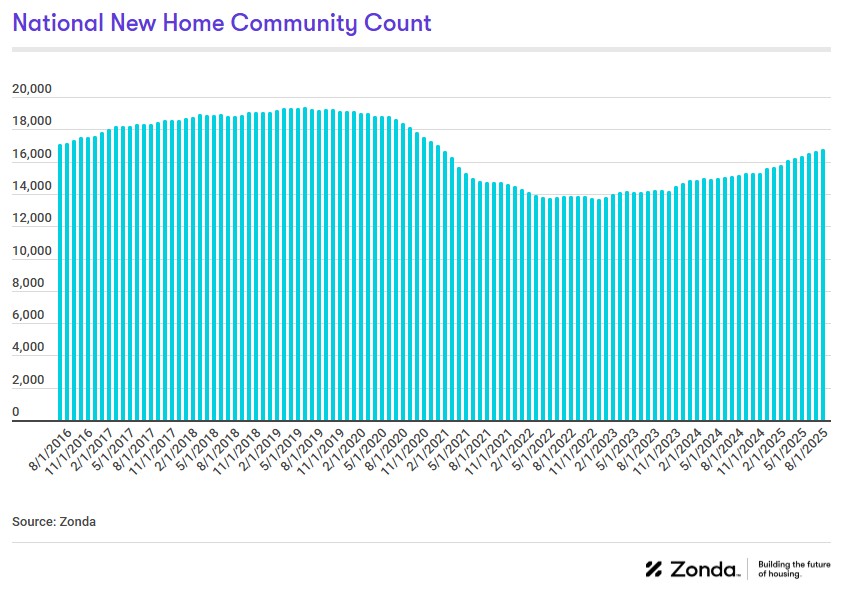
- Tampa (+18.0%), Orlando (+16.5%), and Raleigh (+15.4%) grew community count the most year-over-year.
- Relative to last year, the biggest community count declines were in Philadelphia (-15.8%), Minneapolis (-10.1%), and Washington, DC (-7.0%).
National quick move-ins (QMIs) totaled 41,417, up 25.3% compared to last year and 3.0% lower month-over-month. Total QMIs are 81.6% above 2019 levels. QMIs are homes that can likely be occupied within 90 days.
For many consumers, QMIs provide a great alternative to resale supply given they are brand new and (often) come with builder incentives. These homes aren’t flying off the shelf as they once did, though, so builders are still working through their backlog of inventory but are more cautious with new starts.
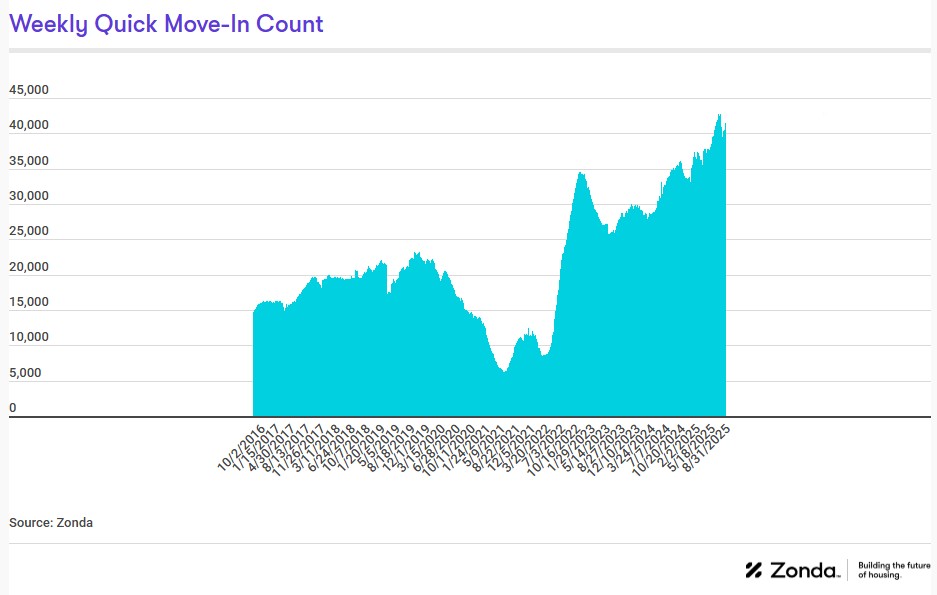
- On a metro basis, 88% of Zonda’s select markets increased QMI count year-over-year.
- The markets up most in QMIs were Washington, DC (+193.6%), Seattle (+155.6%), and Baltimore (+137.5%).
- Las Vegas, Cincinnati, and Salt Lake City have seen the most growth in QMIs compared to the same time in 2019, up 282.2%, 270.7%, and 224.1%, respectively.
QMIs per community is a good way to track how new home supply looks in the context of actively selling projects. There were 2.5 QMIs per community nationally in August, up 14.2% from the 2.2 this time last year and back in-line with levels seen in late-2022.
Please note, the QMI per community data aligns with this report covering August trends. Our quick move-in data is weekly, and we release the latest available at the time of publishing this report. As such, recreating the visual below with the data above will yield slightly different results.
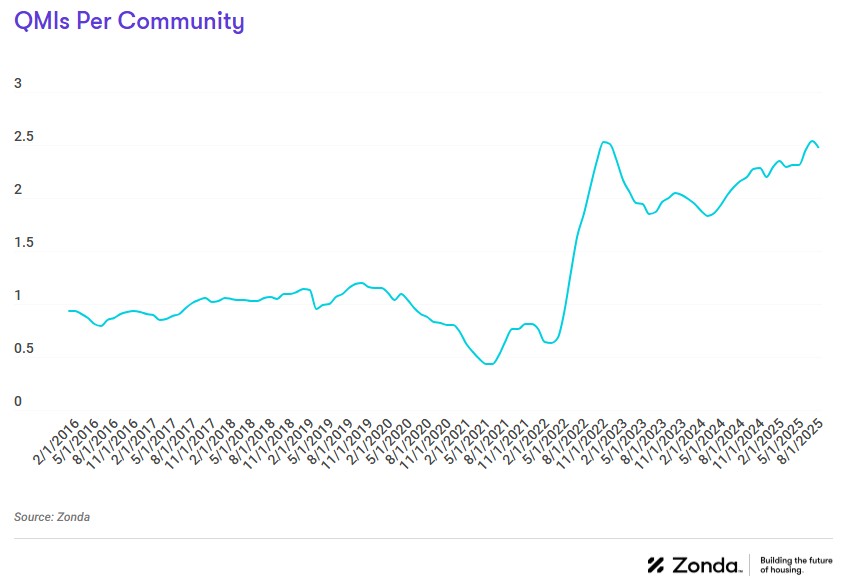
Are you interested in seeing past National Housing Market Update and Pending Sales Index reports? Access our report library to learn more.
Methodology
The Zonda New Home Pending Sales Index (PSI) is built on proprietary, industry-leading data that covers 85% of the production new home market across the United States. Reported number of new home pending contracts are gathered and analyzed each month. Released on the 15th business day of each month, the New Home PSI is a leading indicator of housing demand compared to closings because it is based on the number of signed contracts at a new home community. Zonda monitors 16,000 active communities in the country and the homes tracked can be in any stage of construction.
The new home market represents roughly 10% of all transactions, allowing little movements in supply to cause outsized swings in market activity. As a result, the New Home PSI blends the cumulative sales of activity recently sold-out projects with the average sales rate per community, which adjusts for fluctuations in supply. Furthermore, the New Home PSI is seasonally adjusted based on each markets’ specific seasonality, removes outliers, and uses June 2016 as the base month. The foundation of the index is a monthly survey conducted by Zonda. It is necessary to monitor both new and existing home sales to establish an accurate picture of the relative health of the residential real estate market.
About Zonda
Zonda provides data-driven housing market solutions to the homebuilding industry. From builders to building product manufacturers, mortgage clients, and multifamily executives, we work hand-in-hand with our customers to streamline access to housing data to empower smarter decisions. As a leading brand in residential construction, our mission is to advance the home building industry, because we believe better homes mean better lives and stronger communities. Together, we are building the future of housing.
